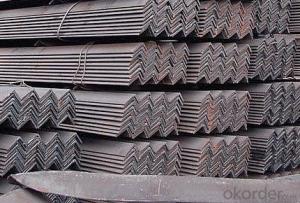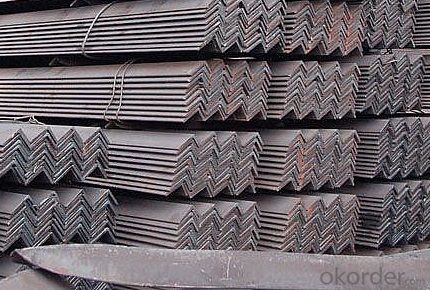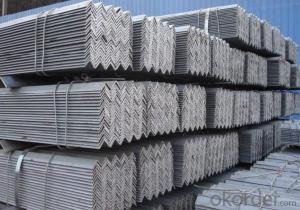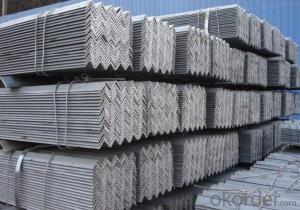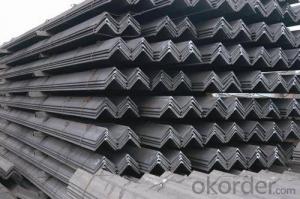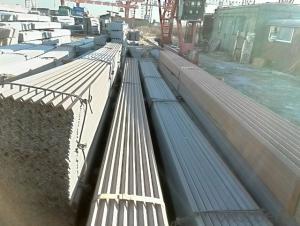High Qualiy Steel Angle
- Loading Port:
- China Main Port
- Payment Terms:
- TT OR LC
- Min Order Qty:
- -
- Supply Capability:
- -
OKorder Service Pledge
Quality Product, Order Online Tracking, Timely Delivery
OKorder Financial Service
Credit Rating, Credit Services, Credit Purchasing
You Might Also Like
Quick Details
Standard:AISI, ASTM, BS, DIN, GB, JIS
Dimensions:20x3----200x24
Grade:Q195-Q420 Series
Model Number:Q235, Q345
Type:Equal
Application:construction
product name:standard angle steel
Standard:ASTM,BS,DIN,GB,JIS
Grade:SS400-SS540 Series
Model Number:Q235, Q345
Application:construction
origion:China
packing:bundle
length:6m 9m 12m
Type:Carbon Structural Steel
Packaging & Delivery
Packaging Details: standard export packing,packed in bundles,suitable sea transport Delivery Detail: 10-15 days after received the payment advance
- Q: What is the maximum deflection allowed for a steel angle beam?
- The maximum deflection allowed for a steel angle beam typically depends on the specific design requirements, loading conditions, and industry standards. To determine the maximum deflection, engineers consider factors such as the beam's span, material properties, and the desired level of rigidity. Therefore, there is no standard maximum deflection for all steel angle beams, as it varies based on the specific application and design considerations.
- Q: How do steel angles perform in extreme temperatures?
- Steel angles are known for their excellent performance in extreme temperatures. Due to their high melting point, steel angles can withstand both extremely high and low temperatures without losing their structural integrity. In extreme heat, steel angles have a high resistance to thermal expansion, meaning they maintain their shape and strength even when exposed to intense heat. Similarly, in extremely cold temperatures, steel angles do not become brittle or weak, ensuring their durability and reliability. This makes steel angles ideal for applications in industries such as construction, automotive, and aerospace, where they are exposed to a wide range of temperatures. Additionally, steel angles also exhibit excellent fire resistance, further enhancing their performance in extreme temperature conditions. Overall, steel angles are a preferred choice for applications requiring stability and strength in extreme temperatures.
- Q: What is the use of angle steel and channel steel?
- Most of the channels are made of trays and cabinets, as well as stationary supports, such as power plants and substations.
- Q: Are steel angles prone to rust or corrosion?
- Steel angles have a tendency to rust or corrode. When steel comes into contact with oxygen and moisture, it undergoes a chemical reaction known as oxidation, which leads to the creation of iron oxide, commonly referred to as rust. This reaction can gradually weaken the structural strength of the steel angles. To prevent or reduce rust and corrosion, it is common practice to coat steel angles with protective layers such as paint, galvanization, or other anti-corrosion treatments. It is essential to regularly perform maintenance and inspections to promptly detect and address any indications of rust or corrosion in order to extend the lifespan and optimize the performance of steel angles.
- Q: 6# specification for angle iron
- The angle iron can be made up of different force components according to the different structure, and can also be used as the connecting piece between the components. It is widely used in various architectural and engineering structures, such as beams, bridges, towers, hoisting and conveying machinery, ships, industrial furnace, reaction tower, container rack and warehouse shelves.
- Q: How do you prevent steel angles from bending under load?
- In order to prevent steel angles from bending under load, several important measures can be taken: 1. Choose the appropriate size and material for the angle: It is important to select a steel angle that is of sufficient size and material strength to withstand the expected load. Seeking guidance from structural engineering guidelines or professionals can help determine the correct dimensions and material composition for the specific application. 2. Strengthen the angle: Enhance the strength of the steel angle by adding additional support or reinforcement. This can be achieved through techniques such as welding extra plates to the angle, utilizing gussets or stiffeners, or incorporating diagonal bracing. These reinforcements help distribute the load more evenly and reduce the likelihood of bending. 3. Increase the thickness: If possible, increasing the thickness of the steel angle can improve its ability to bear loads. A thicker angle will have greater resistance to bending and deformation under load. 4. Ensure proper installation: It is crucial to install the steel angles correctly and securely in order to maximize their resistance to bending. This involves using appropriate fasteners, such as bolts or welds, and following proper installation techniques. 5. Avoid excessive loads: Preventing steel angles from bending under load also requires careful consideration of the maximum load they will encounter. It is important to avoid overloading the angles beyond their design capacity, as this significantly increases the risk of bending or failure. 6. Regular inspections: Regularly inspect the steel angles for any signs of bending, cracking, or deformation. Prompt identification of potential issues allows for timely maintenance or reinforcement, preventing further damage or accidents. To ensure the proper design and implementation of these measures, it is crucial to consult with a qualified structural engineer or professional experienced in steel fabrication.
- Q: Can steel angles be used for framing or supporting partitions?
- Yes, steel angles can be used for framing or supporting partitions. Steel angles are commonly used in construction due to their strength and durability. They provide excellent support and stability, making them suitable for framing or supporting partitions in various structures.
- Q: How many meters is one angle steel?
- Angle called angle, the steel strip is perpendicular to each other on both sides into the corner. There are equal angles and unequal angles. The two sides of an equal angle steel are equal in width. The specifications are expressed in millimeters of edge width * edge width * edge thickness. Such as "/ 30 x 30 x 3", that is 30 mm width equal angle, edge thickness of 3 mm. Also available models that model is the number of centimeters wide, such as angle 3#. The model does not mean the size of the different edges and sizes of the same model. Therefore, the width, the edge and the thickness of the angle iron should be filled out in the contract and other documents, so as not to be indicated by the model alone.
- Q: What is the cost of steel angles compared to other materials?
- The cost of steel angles compared to other materials can vary depending on various factors such as the type and grade of steel, market conditions, and availability. However, in general, steel angles tend to be a cost-effective option when compared to other materials commonly used for structural or construction purposes. Steel angles are widely used in various industries including construction, manufacturing, and infrastructure due to their durability, strength, and versatility. Compared to materials like aluminum or stainless steel, steel angles are often more affordable. This is because steel is a widely available material and can be produced in large quantities, leading to cost efficiencies in manufacturing processes. Additionally, steel angles have a long lifespan and require minimal maintenance, further contributing to their cost-effectiveness over time. They also offer excellent load-bearing capabilities, making them suitable for a wide range of applications, including building frames, support structures, and machinery. However, it is important to note that the cost of steel angles can still vary depending on the specific requirements and specifications of a project. Factors such as size, length, thickness, and any additional treatments or finishes can influence the price. Therefore, it is advisable to consult with suppliers or manufacturers to obtain accurate and up-to-date pricing information based on individual project needs.
- Q: What is the process of hot rolling steel angles?
- The process of hot rolling steel angles involves heating a billet of steel to extremely high temperatures and then passing it through a series of rotating rollers. These rollers apply pressure to the billet, shaping it into the desired angle profile. The hot rolling process helps to improve the structural integrity and overall strength of the steel angles. After hot rolling, the angles are cooled and then cut to the desired length.
Send your message to us
High Qualiy Steel Angle
- Loading Port:
- China Main Port
- Payment Terms:
- TT OR LC
- Min Order Qty:
- -
- Supply Capability:
- -
OKorder Service Pledge
Quality Product, Order Online Tracking, Timely Delivery
OKorder Financial Service
Credit Rating, Credit Services, Credit Purchasing
Similar products
Hot products
Hot Searches
Related keywords
